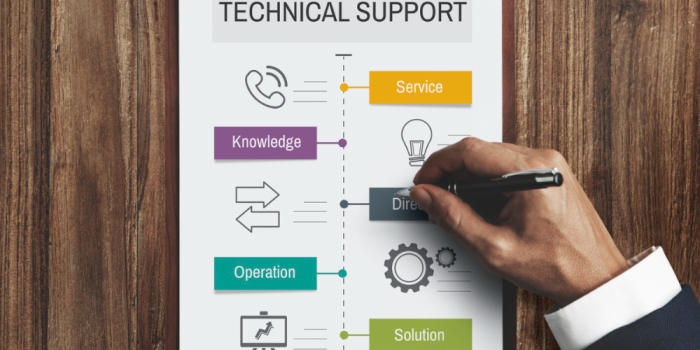In today’s AI-driven world, following a reliable IT support plan is crucial for all businesses. From small startups to large enterprises, the right IT operations will boost your productivity and enhance your overall success. However, with so many providers out there, finding the ideal match can seem overwhelming. But don’t worry! This article will walk you through a detailed process for selecting an IT support plan that meets your business’s specific needs and objectives.
What is an IT Support Plan?
An IT support plan is a comprehensive strategy that ensures the smooth functioning and protection of your company’s IT infrastructure. It serves as a proactive defense against security risks, unplanned downtime, server crashes, and any other technology-related issues.
Elements of an IT Support Plan
An IT support plan consists of several key elements that work together to ensure the smooth functioning and protection of your business’s technology infrastructure. These elements include:
- Remote Support: This includes network administration, software updates, and security protocol monitoring, all performed remotely when your equipment is functioning normally. Small and medium-sized businesses often opt for Managed Service Providers to access a 24/7 expert help desk support team at a fraction of the cost of an in-house IT department.
- On-Site Support: While remote access can resolve many technical problems, certain hardware issues require on-site assistance. Routine maintenance of workstations, servers, printers, and portable devices also falls under on-site support. Scheduling on-site support with a Managed Service Provider allows your business to plan for maintenance and minimize disruptions.
- End-User Support: This addresses individual user problems, such as printer connectivity issues or computer malfunctions due to malware or viruses. End-user support can often be handled remotely, but on-site visits may be necessary in some cases.
- Emergency Support: Despite regular maintenance, unexpected events like virus attacks, email server hacks, or physical disasters can occur. A robust IT support plan includes immediate emergency support, even during weekends, holidays, or late at night.
How to Choose the Right IT Support Plan and Services for Your Business

Before selecting the most suitable IT support plan for your business, it’s essential to understand your business’s unique needs. The following steps will guide you in identifying your IT support needs:
1. Assessing the Current IT Infrastructure
Start by taking inventory of your existing IT assets, such as computers, servers, and software licenses. This will provide insights into your current IT environment and aid in future planning.
Evaluate your network setup, including routers, switches, and firewalls, to understand your network’s architecture for efficient troubleshooting and scalability.
2. Identifying Business Goals and Objectives
Consider your business’s short-term and long-term goals and the role IT will play in achieving these objectives. For instance, if you plan to expand your e-commerce platform, you’ll need an IT support plan in web hosting and online security.
3. Analyzing IT Pain Points and Challenges
Reflect on past IT issues that have disrupted your business operations, such as network downtime, software glitches, or security breaches. Identifying these pain points will help prioritize critical aspects of IT support.
4. Budget Considerations
Determine your IT support budget. While investing in reliable support is crucial, finding a solution that aligns with your financial resources is equally important. A well-planned IT budget prevents overspending and ensures maximum value from the chosen support service.
What Kind of Services Should You Ideally Expect from Your IT Support Plan?
An effective IT Support Plan is crucial for every business for smooth operation and security. Here’s what an ideal IT Support Plan should include:
- Around-the-Clock Monitoring: Expect your IT team to continuously watch over your systems to prevent issues from impacting your business. This covers monitoring the health and security of servers, networks, and devices.
- Helpdesk and Technical Support: A dedicated helpdesk should be available to address your team’s IT concerns, offering solutions for hardware, software, and connectivity troubles, including remote assistance.
- Comprehensive Security Measures: Look for services that manage firewalls, provide antivirus solutions, and implement data backup strategies to defend against cyber threats.
- Backup and Disaster Recovery Plans: A strong plan includes backup solutions and disaster recovery strategies to ensure data integrity and quick recovery from data loss or hardware failures.
- Strategic IT Consulting: Expect guidance on aligning technology with business objectives, planning for future IT needs, and making informed tech investments.
- Cloud Computing Support: Assistance with cloud migration, management, and optimization, including infrastructure and data storage solutions.
- Analytics and Reporting: Regular reports on IT performance and system health help inform business decisions and highlight improvement areas.
- Regulatory Compliance and Audits: Your plan should include compliance audits and assistance in maintaining standards for businesses in regulated industries.
Tips for Managing and Maximizing The Potential of Your IT Support Service Team
Securing the ideal IT support plan is the first step. To maximize the potential of your IT support service team, follow these strategies to manage your IT support effectively:
1. Communication and Teamwork
Keep a steady stream of communication with your IT support team. Regular updates and discussions will ensure their activities are in sync with your business’s changing demands. Effective teamwork is crucial for discovering preventative measures and eliminating repetitive issues.
2. Routine Maintenance and Software Upgrades
Addressing issues before they escalate is usually more budget-friendly than fixing problems post-occurrence. Regularly scheduled software maintenance and updates are essential to reduce risks and boost system efficiency.
3. Staff Training and Development
Empower your employees with training and educational resources. Knowledgeable staff members can lessen the need for frequent support calls, leading to a more productive IT setup.
4. Implement Monitoring and Analysis Reports
Use monitoring solutions to oversee the health and efficiency of your IT infrastructure. Analyze reports and data from your IT support service regularly to pinpoint trends and potential improvement areas.
5. Continuous Evaluation and Adaptation
The IT field is constantly changing. It’s important to periodically assess your IT support plan to ensure it remains aligned with your business objectives. Be open to making changes or seeking new solutions as needed.
Frequently Asked Questions
Conclusion: Choosing the Right IT Support Plan for Your Business
In today’s competitive business landscape, having a reliable IT support plan is not just an option but a necessity. By following the steps outlined in this guide, you can select the ideal IT support plan that aligns with your business’s unique needs and objectives. Remember, effective IT support goes beyond resolving technical issues; it’s about ensuring your business’s smooth operation, security, and growth.

